AMD Zen 4 Ryzen 9 7950X and Ryzen 5 7600X Review: Retaking The High-End
by Ryan Smith & Gavin Bonshor on September 26, 2022 9:00 AM ESTCPU Benchmark Performance: Power, Web, And Science
Our previous set of ‘office’ benchmarks has often been a mix of science and synthetics, so this time we wanted to keep our office section purely on real-world performance. We've also incorporated our power and science testing into this section too.
In this version of our test suite, all the science-focused tests that aren’t ‘simulation’ work are now in our science section. Where possible these benchmarks have been optimized with the latest in vector instructions.
We are using DDR5 memory on the Ryzen 9 7950X and Ryzen 5 7600X, as well as Intel's 12th Gen (Alder Lake) processors at the following settings:
- DDR5-5200 CL44 - Ryzen 7000
- DDR5-4800 (B) CL40 - Intel 12th Gen
All other CPUs such as Ryzen 5000 and 3000 were tested at the relevant JEDEC settings as per the processor's individual memory support with DDR4.
Power
The nature of reporting processor power consumption has become, in part, a dystopian nightmare. Historically the peak power consumption of a processor, as purchased, is given by its Thermal Design Power (TDP, or PL1). For many markets, such as embedded processors, that value of TDP still signifies the peak power consumption. For the processors we test at AnandTech, either desktop, notebook, or enterprise, this is not always the case.
Modern high-performance processors implement a feature called Turbo. This allows, usually for a limited time, a processor to go beyond its rated frequency. Exactly how far the processor goes depends on a few factors, such as the Turbo Power Limit (PL2), whether the peak frequency is hard coded, the thermals, and the power delivery. Turbo can sometimes be very aggressive, allowing power values 2.5x above the rated TDP.
AMD and Intel have different definitions for TDP but are broadly speaking, applied the same. The difference comes from turbo modes, turbo limits, turbo budgets, and how the processors manage that power balance. These topics are 10000-12000 word articles in their own right, and we’ve got a few articles worth reading on the topic.
- Why Intel Processors Draw More Power Than Expected: TDP and Turbo Explained
- Talking TDP, Turbo and Overclocking: An Interview with Intel Fellow Guy Therien
- Reaching for Turbo: Aligning Perception with AMD’s Frequency Metrics
- Intel’s TDP Shenanigans Hurts Everyone
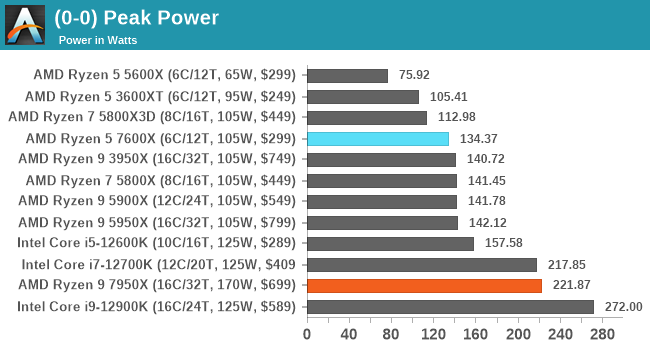
Looking at the results of our Peak Power test, the Ryzen 9 7950X topped out at 221.8 W, which is around 30% higher than the TDP of 170 W it comes with. As stated by AMD, the Power Package Tracking or PPT limit for AM5 motherboards when used with 170W TDP Ryzen 7000 SKUs will be 230 W. Still, while it draws more power than its generational predecessors such as Zen 3 and Zen 2, the Zen 4-based Ryzen 7000 series benefits from higher core clock speeds, a higher single core boost frequency, as well as other implementations around TSMC's 5 nm manufacturing process.
The AMD Ryzen 5 7600X is more aimed at the mid-range, and as such has a lower overall power draw, with the peak power figures in our testing reaching 134.3 W. This is around the same levels of power draw as the Ryzen 9 3950 X, the Ryzen 9 5900X, and the Ryzen 7 5800X. Per AMD's specifications, the Ryzen 5 7600X has a TDP of 105 W, with around a 27 % variance in peak power compared to TDP.
From our testing, so far, it seems that Ryzen 7000 when combined with a premium X670E motherboard allows for up to 30% in terms of extra power allowances for higher single-core boost and overall faster all-core frequencies.
Web
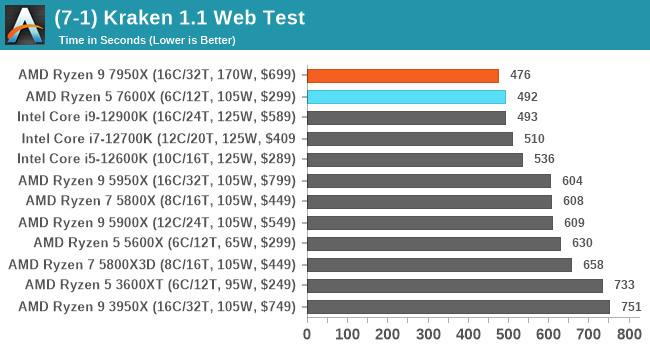
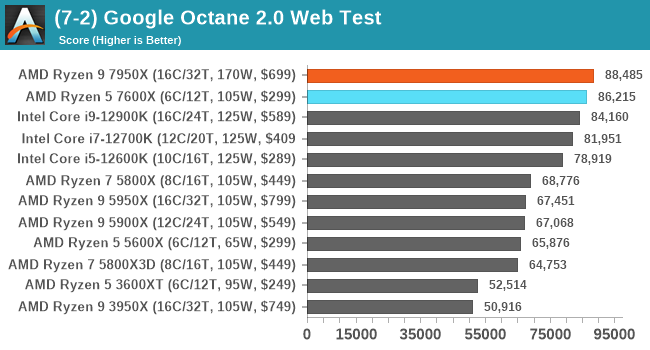
In our web tests, the overall improvements in IPC, frequency, clock speeds, and the switch to DDR5 all play a part in performance here. Both the Ryzen 9 7950X and Ryzen 7 7600X top our charts in regards to web testing, although performance isn't as apparent as it should be in other areas.
Science
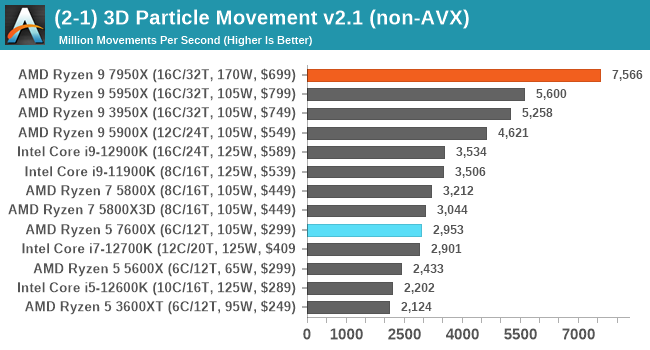
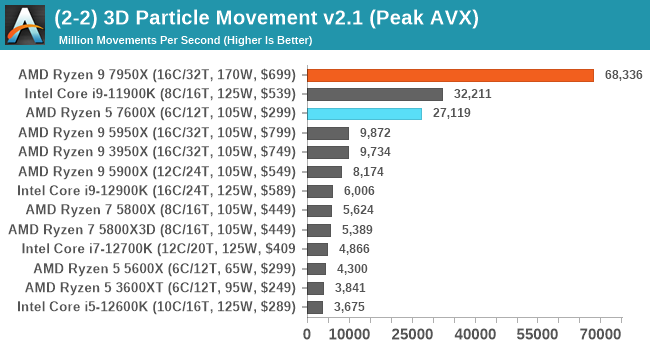
For our 3DPM v2.1 testing, we added in the Intel Core i9-11900K (Rocket Lake) to show performance across AVX workloads. Although Intel officially fused off the AVX2/512 extensions on Alder Lake which did cause a little controversy and gave the impression that AVX-512 on consumer platforms was dead. AMD clearly believes the opposite, as it has implemented it so that AVX-512 runs two cycles over a 256-bit wide instruction. The performance of the Ryzen 9 7950X here is phenomenal, although the Core i9-11900K which did indeed feature AVX instruction sets in the silicon, is still better than the Ryzen 5 7600X with AVX workloads.
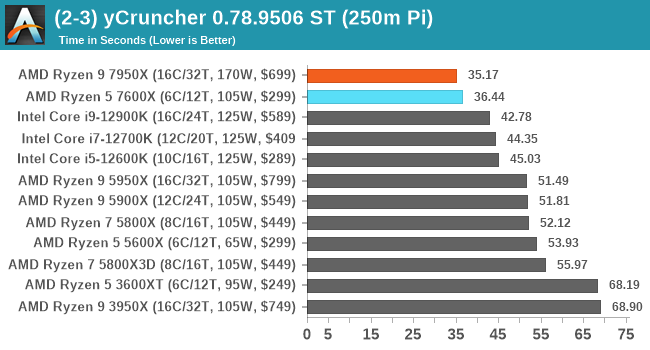
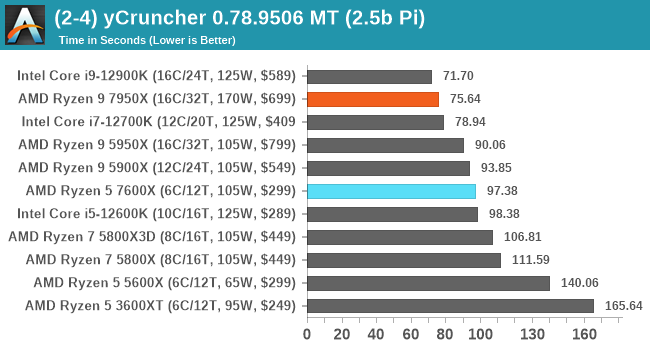
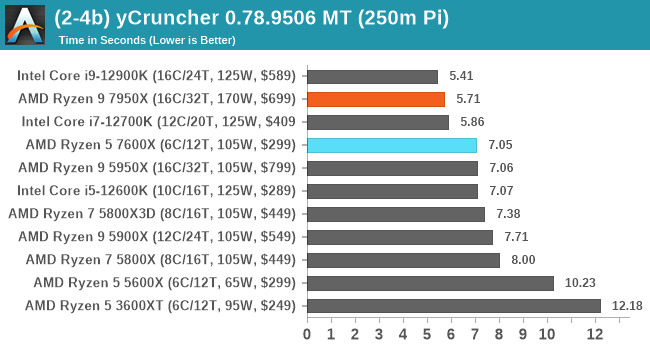
Focusing on our more science-based tests, both the Ryzen 9 7950X and Ryzen 5 7600X perform well against the competition. In our 3DPMv2.1 test in non-AVX, the Ryzen 9 7950X provided a jump of 35% in performance against the previous generation Ryzen 9 5950X processor.
Interestingly, in our yCruncher 0.78 test, the Ryzen 9 7950X and the Core i9-12900K trade blows consistently, although the Ryzen 5 7600X performs well for its price point.










205 Comments
View All Comments
AndrewJacksonZA - Monday, September 26, 2022 - link
I would imagine it's a technically correct way of saying that it's certified for Windows 11. See here about the TPM:www DOT microsoft DOT com/security/blog/2020/11/17/meet-the-microsoft-pluton-processor-the-security-chip-designed-for-the-future-of-windows-pcs/ Reply
socket420 - Monday, September 26, 2022 - link
I'm primarily asking whether or not the Pluton security coprocessor has been incorporated into Raphael/Ryzen 7000 CPUs, and I'm pretty sure that isn't what they were implying - Microsoft *does* have a "secured-core PC" baseline for Win11 they've been pushing lately, but it's currently unclear how Pluton ties into that so I don't think Win11 "certification" has anything to do with it. Pluton wasn't mentioned in AMD's desktop Ryzen 7000 press release last month, I didn't see it in any of the Zen 4 architectural slides they showed off today and AnandTech is the only outlet that's brought it up at all, which is why I'm asking this question in the first place - AMD hasn't been particularly forthcoming about the subject and I feel like they would've mentioned Pluton in a press release if it was actually present in these chips. ReplyRyan Smith - Monday, September 26, 2022 - link
I am not privy to the implementation details. But like other parts of the IOD, Pluton is inherited from the Ryzen 6000 Mobile parts. So it has the same Pluton implementation as those mobile chips.TL;DR: I don't know how they're technically accomplishing it, but yes, Pluton is there and enabled. Reply
socket420 - Tuesday, September 27, 2022 - link
Thanks for the response. Just to clarify, if I reread that section correctly, the Ryzen 7000 I/O die is a new design that had most of the additions from Ryzen 6000 ported over to it, Pluton included. That sounds incredibly damning, but I'm not sure how it's possible to confirm its presence without implementation details. I'm also unsure why AMD would brag about Pluton being present in two different mobile CPU releases from the moment they were announced while seemingly ignoring it in their new and shiny desktop Ryzen lineup up until its release date (are they hoping we won't notice?), but then again, it's been months since Ryzen 6000 was launched and no one's taken a closer look at its Pluton implementation yet, so :/IIRC, Lenovo ships their Ryzen 6000 Thinkpads with Pluton disabled and you have to go into their BIOS to toggle it on or off, so maybe that option showing up on consumer AM5 boards will show us if Pluton's there or not? It'd also be cool if someone asked AMD directly for a response, but Robert Hallock said he "didn't know" if Pluton was in Zen 4 and he coincidentally just left the company, so I have no idea who to reach out to. Reply
Silver5urfer - Tuesday, September 27, 2022 - link
Thanks for your question and this new garbage Pluton cancer is what I did not want to see shame how they added it. ReplyOxford Guy - Tuesday, September 27, 2022 - link
You will own nothing and be owned by everything. You will be happy. ReplyValantar - Monday, September 26, 2022 - link
Could you please run your per-core power draw tests for these chips like you did for Zen3? Replytakling1986 - Monday, September 26, 2022 - link
I think this review is "streets ahead". ReplyIBM760XL - Monday, September 26, 2022 - link
All right, since they aren't read yet, I'll ask... is it easy to set a lower TDP limit, and could you examine power efficiency when the TDP is the same as it was for Ryzen 5000?Looking at the numbers Tom's Hardware posted, the 7950X uses about 80W more at load than the 5950X. With AMD's own slides touting the efficiency improvements being greater at lower TDPs, what I'd really like is to have an octo-core at 65W like the 5700, or perhaps a 12/16 core at 105W like the 5900/5950.
Though I'm very likely to wait until B650 drops before making a decision, so there's plenty of time for an answer to that question to arrive. Reply
abufrejoval - Wednesday, September 28, 2022 - link
I can only guess that it should be trival to do via RyzenMaster, just in case it's not supported in the BIOS. And of course I'd demand CLI tools for both Linux and Windows.I cannot imagine that with a max TDP of 140 Watts a 7950X won't still be faster than a 5950X, even if it won't be quite as fast as if you let it drain the bottle at full hilt. The typical CMOS knee will still be there, only moved forward a bit and with a lot more of a "hot leg" showing towards the top.
But gains per clock and Watt will be terrible the higher you go on the "hot leg" by nature of silicon physics and any sensible person will just use a "lesser cooler" to avoid that nonsense. Reply